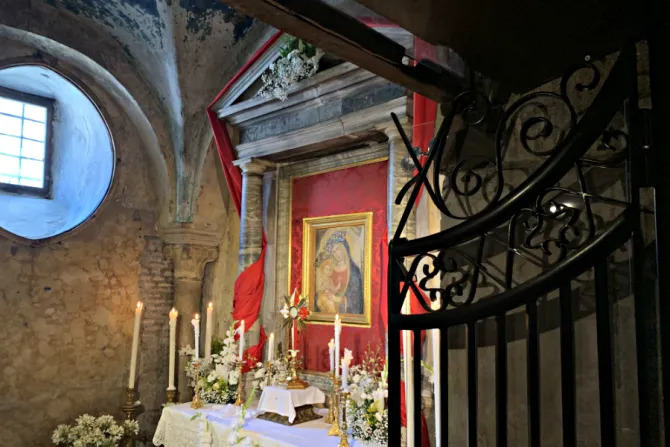Rome, Italy, Jul 11, 2019 / 04:45 am
Before St. Benedict left for Subiaco, he studied in Rome, where today there is a little-known chapel built on the site believed to be his former residence.
Locals are celebrating St. Benedict's July 11 feast this year with 40 hours of continuous Eucharistic adoration in this historic chapel in the Church of St. Benedict in Piscinula.
St. Benedict and his twin sister St. Scholastica were born in the 5th century into a noble family in Nursia. In 495, Benedict was sent to study in Rome, where he is believed to have lived with his relatives, the Anici family, at their villa Domus Aniciorum.
While studying in Rome, St. Benedict was disillusioned by the immorality of his classmates and companions, and eventually left Rome to live as a hermit in a cave in Subiaco.
The Church of St. Benedict in Piscinula, in Rome's Trastevere neighborhood, was built on what tradition holds to be the site of St. Benedict's room in the former villa. A small chapel was first constructed there in the 7th century and has been destroyed and rebuilt many times since.
"Between the silence of these walls, God gave him the first graces, which would later culminate in the foundation of the cultural and religious work which would forever mark the future of Europe and the West: the Benedictine Order," reads a plaque in the Church of St. Benedict's Chapel of the Madonna.
St. Benedict's feast day is being celebrated in Rome this year with three days of adoration and Masses in the chapel organized by the Heralds of the Gospel, a Catholic movement officially recognized by St. Pope John Paul II in 2001.
The Church of St. Benedict in Piscinula was entrusted to the Heralds of the Gospel by the vicar of Rome in 2003.
The church's "historical and symbolic value is high, given that the patron saint of Europe was converted precisely in this place, in making the decision to become a hermit, abandoning the promising worldly future he would have achieved at the end of his senatorial studies," Father Carlos Werner, president of the Italian section of the Heralds of the Gospel, told ACI Stampa.
The small Church of St. Benedict in Rome is also known for having one of the oldest and smallest bell towers in the Eternal City -- dating back to the 11th century -- and a Medieval geometric stone "cosmatesco" floor.
"Benedict offers us the non-controversial proof of how the Gospel can be penetrated into the concrete history of men, bringing to it a transforming dynamism, capable of unexpected, beneficial developments," Pope St. John Paul II said in Subiaco in 1980.
"May God grant the men of today to accept this fruitful lesson and to move decisively, following in the footsteps of St. Benedict, on the paths of mutual respect, of loyal openness, of generous sharing, of a united commitment, in a word, on the roads of love," he said.



